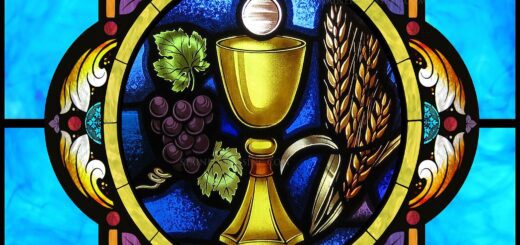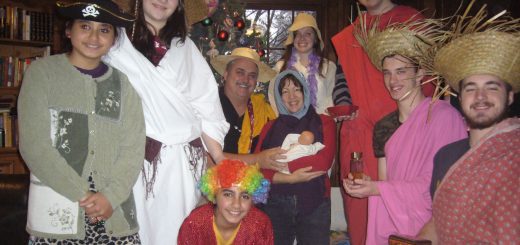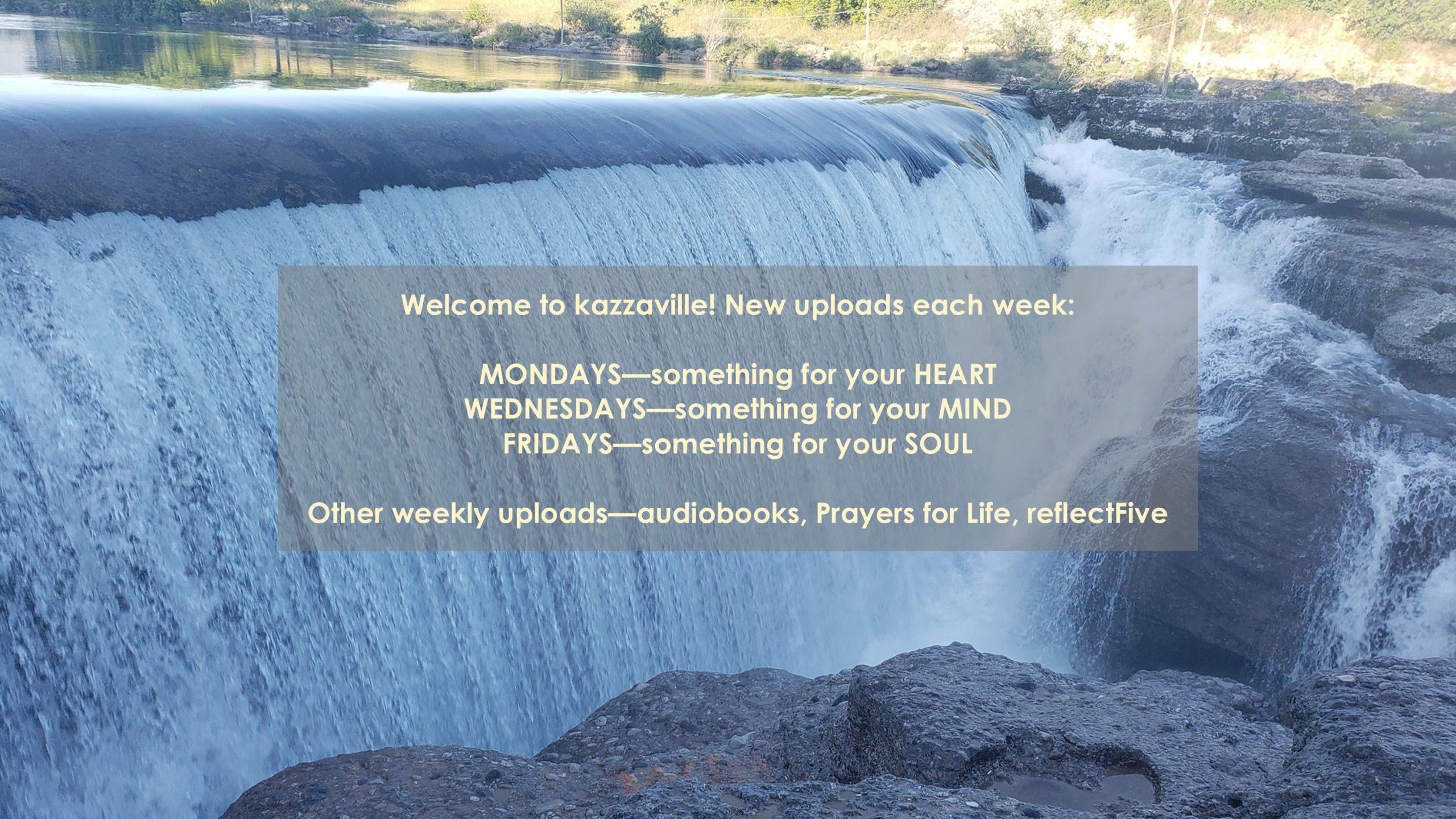Mystery: The Elusive Lover
Today’s topic in our series on the attributes of God, “A Great and Terrible Love” is mystery. We may not consciously think about this every day, but if we consider even briefly what God is like, we quickly reach the conclusion that we simply can’t wrap our brains around all that He is. We are finite; He is infinite. Our thinking, reasoning, and understanding are limited. We are created beings firmly planted in space and time. God is from eternity past to eternity future, without beginning or end, not trapped in a single location or moment.
Let’s look at a description Ezekiel wrote about a heavenly vision he was given:
Ezekiel 1:26-28 (KJV) – “And above the firmament that was over their heads was the likeness of a throne, as the appearance of a sapphire stone: and upon the likeness of the throne was the likeness as the appearance of a man above upon it. And I saw as the colour of amber, as the appearance of fire round about within it, from the appearance of his loins even upward, and from the appearance of his loins even downward, I saw as it were the appearance of fire, and it had brightness round about. As the appearance of the bow that is in the cloud in the day of rain, so was the appearance of the brightness round about. This was the appearance of the likeness of the glory of the LORD . . .”
Even in this epiphany, God remains shielded by the vague and evasive language Ezekiel is forced to employ. Although Ezekiel had a vision of God, God remained hidden.
God created us for the purpose of glorifying Him and enjoying Him forever, as stated in the Westminster Shorter Catechism. God wants us to glorify Him and enjoy Him. But what is God like? Thank God that He has made a way for us to know Him. But that verb “to know” has layers of meaning, doesn’t it? We can know facts – I know that there are 2 light switches on the wall over there. We can know opinions – I know that yesterday meteorologists said there was a 30% chance of rain. We can know a few things about each other – I know that Kristen writes poetry. But think about it – we can hardly know EVERYTHING about any person, even a person with whom we are most intimate. Paul and I have been married for 26 years, and yet we do not know one another completely. I spent almost every waking moment with each of my children when they were very young, and yet every day brought new discoveries about who they are. That’s one of the delights about human relationships – as long as we don’t put one another in a neat little box that defines who we think they are, and as long as we tend the gardens of our hearts and hold them open to one another and desire to get to know one another more, our relationships can continue to grow and blossom. How much more so with God!
1 Kings 8:12 (The Message) – “God has told us that he lives in the dark where no one can see him”
There is no limit to the knowledge of God. It’s not just head knowledge I’m talking about. Knowing God is the most intimate kind of knowing possible. A little knowledge of God can be a dangerous thing. If we think we have figured out any aspect of God completely, we are kidding ourselves. I grew up in a heady kind of family where knowledge was greatly valued. But in any area of study, I quickly realize that the more I know, the more I know I don’t know! As children, we think that living things consist of plants and animals. Then we mature a little and find out that there are also bacteria, fungi, archaea, and viruses. Then we grow a little more and find out that some living things defy being categorized in one of our neat little boxes. In childhood we think there are butterflies and bees and ants and grasshoppers. Then we grow a little more and discover there are more than 1.5 million species of insects alone. As sophisticated as we think we are, every year there are new discoveries that make us realize, if we have even an ounce of humility, that the more we know in any field of study, the more we realize we don’t know, and the more discoveries remain to be made!
God is knowable and unknowable at the same time. I guess the best way to think about our knowing of God is that God has graciously given us a way to begin to get to know Him, and we will spend the rest of eternity delighting in getting to know Him more and more.
Psalm 36:5-6 (The Message) – “God’s love is meteoric, his loyalty astronomic, His purpose titanic, his verdicts oceanic. Yet in his largeness nothing gets lost . . .”
If we think we have God figured out, then we’ll expect Him to answer our prayers in a certain way, or expect Him to bless something we do, or want certain kinds of answers when we face tragedy . . . but we’ll go to the box we’ve put Him in and discover that He’s not there. This is one of the reasons it’s possible for believers to become disillusioned with God. It’s not that God has done anything inconsistent with His character – God is the same yesterday, today, and forever. The problem is that we put ourselves in great danger the moment we stop seeking to know God. And the danger is greatest to our own souls. True freedom, true love, true peace, true joy come only one way – by knowing God. God is more than we can ever comprehend, more beautiful, more magnificent, more marvelous, more wonderful! Yes, we know God, but there will always be more of God to know. We can know many facts about God that are true. We can list His attributes and discuss them, as we are doing in this series. These are helpful and important in our journey. But we won’t truly grasp who God is until we recognize that the more we understand and know about God, the more we don’t understand or know about Him! We worship a God shrouded in mystery. What a joy it is when we realize that the mystery of God is not a stumbling block, nor a puzzle to be solved, but something that draws us toward Him in both wonder and joy.
Paul wrote in 1 Corinthians 13:12 (NLT) – “Now we see things imperfectly, like puzzling reflections in a mirror, but then we will see everything with perfect clarity. All that I know now is partial and incomplete, but then I will know everything completely, just as God now knows me completely.”
This verse got me wondering about the quality of mirrors when Paul wrote this in approx. AD 53-57. The Romans developed a technique for creating crude mirrors by coating blown glass with molten lead, but only the rich could afford them, and probably not until a century or two after Paul wrote this. Mirrors at that time were not very good reflectors – you got a basic idea but there was nowhere near the clarity or wide availability we enjoy today until the mid-1800s. The NLT translation is particularly good here – puzzling reflections – a modern equivalent for us would be trying to offer positive identification about someone while looking through those thick glass-blocks that are sometimes used in bathrooms – they allow light to pass through, but only the vaguest of images – just an outline and an incomplete one at that. Now we see things imperfectly, like puzzling reflections in a mirror. God is mystery. It is not possible on this side of eternity for us to see perfectly or completely. God knows us completely, but we can only know Him partially and incompletely until that glorious day when we see Him face-to-face.
Why is God so elusive? This is not only personally puzzling but socially embarrassing for those of us who believe in the God who is supposed to be in the business of making Himself known! We keep telling people that God is near, that God loves them. It would help if He’d show up and at least shake hands when we’re trying to introduce Him. Instead He often hides behind the door as we talk about Him, motioning Him to come on over.
An 18th century aged peasant described how he spent hours in a chapel – “I look at Him, He looks at me, and we are happy.” One of the delights of motherhood for me was the utter fascination I felt with each newborn infant who did nothing but lie there and look adorable, asleep more often than awake! As we seek to know God more, we can grow from communicating with God through language to communing with God through the gaze of love. When we commune with God, letting go of all effort to speak or even to listen, simply becoming quiet before God, He is free to work His healing mysteries in us, releasing us from bondage, energizing new patterns of life, restoring our soul’s beauty. There is, in contemplating Christ, the Son of God, a salve for every suffering; in meditating on God the Father, there is serenity for every sorrow; and in being influenced by the Holy Spirit, there is soothing for every sore. Let us press on to know the Lord . . . by being still and knowing that He is God!
I’d like for us to spend the rest of our time looking at two particular mysteries – Trinity and Communion.
Trinity:
Here are some excerpts from the Creed of St. Athanasius, a 4th century theologian and Church Father (keep in mind that the word “catholic” means “pertaining to the whole Christian body or church”):
. . . The Catholic Faith is this: That we worship one God in Trinity, and Trinity in Unity, neither confounding the Persons, nor dividing the Substance. For there is one Person of the Father, another of the Son, and another of the Holy Ghost. But the Godhead of the Father, of the Son, and of the Holy Ghost, is all one, the Glory equal, the Majesty co-eternal. Such as the Father is, such is the Son, and such is the Holy Ghost. The Father uncreate, the Son uncreate, and the Holy Ghost uncreate. The Father incomprehensible, the Son incomprehensible, and the Holy Ghost incomprehensible. The Father eternal, the Son eternal, and the Holy Ghost eternal . . . So likewise the Father is Almighty, the Son Almighty, and the Holy Ghost Almighty . . . So the Father is God, the Son is God, and the Holy Ghost is God. And yet they are not three Gods, but one God. So likewise the Father is Lord, the Son Lord, and the Holy Ghost Lord. And yet not three Lords, but one Lord . . . The Father is made of none, neither created, nor begotten. The Son is of the Father alone, not made, nor created, but begotten. The Holy Ghost is of the Father and of the Son, neither made, nor created, nor begotten, but proceeding . . . the Unity in Trinity and the Trinity in Unity is to be worshipped. He therefore that will be saved must thus think of the Trinity.
The 1805 hymn “Father in Heaven” mentions the mystery of the Trinity:
Jehovah! Father, Spirit, Son!
Mysterious Godhead! Three in One!
There are many Scriptures we may refer to that speak of the Trinity, although the word “Trinity” does not appear in the Bible. Here are two key verses:
Deuteronomy 6:4 (NIV) – “Hear, O Israel: The LORD our God, the LORD is one.”
Matthew 28:19 (NIV) – “Therefore go and make disciples of all nations, baptizing them in the name of the Father and of the Son and of the Holy Spirit”
Here are some quotes regarding the Trinity:
From John Arrowsmith, a 17th century English theologian and academic: “The Trinity is a mystery which my faith embraces as revealed in the Word, but my reason cannot fathom.”
From Francis Crawford Burkitt, a divinity professor at Cambridge in the early 1900s: “No wonder that the doctrine of the Trinity is inexplicable, seeing that the nature of God is incomprehensible. Our faith must assent to what our reason cannot comprehend, otherwise we can never be Christians.”
From A. W. Tozer, well-known American pastor, preacher, and author who died in the year of my birth: “Love and faith are at home in the mystery of the Godhead. Let reason kneel in reverence outside.”
From Thomas Watson, a preacher, not Edison’s lab assistant: “The Trinity is purely an object of faith, the plumbline of reason is too short to fathom this mystery; but where reason cannot wade, there faith must swim . . . This sacred doctrine, though it be not against reason, yet is above reason.”
Christianity rests on the doctrine of the Trinity. J. I. Packer in his book, “Knowing God” says that it is often assumed that the doctrine of the Trinity, just because it is mysterious, is a piece of theological lumber that we can get on very happily without. Think back to your own Christian experience – how often have you heard a sermon or teaching on the Trinity? I wonder what the apostle John would say, if he were able to visit our modern era, seeing how clearly he conveyed in the books of John, his letters, and Revelation that the doctrine of the Trinity is an essential part of the Christian gospel. Packer, who is considered one of the most influential Christian theologians of our day, remarks that the average Christian, deep down, is in a complete fog as to the concept of the Trinity.
Proverbs 3:5 (Amplified Version) – “Lean on, trust in, and be confident in the Lord with all your heart and mind and do not rely on your own insight or understanding.”
Vladimir Lossky in his book, “The Mystical Theology of the Eastern Church”, says that we must renounce both sense and all the workings of reason, everything which may be known by the senses or the understanding, both that which is and all that is not, in order to be able to attain in perfect ignorance to union with Him who transcends all being and all knowledge. In addition, we must abandon all that is impure and even all that is pure. It’s only after we leave behind everything that we can penetrate to the darkness where God who is above and beyond all created things makes His dwelling. Our goal is an ascent towards God the Trinity, who transcends everything, including Creation and concepts.
In contrast to the changeability and contingencies of human nature, the Trinity is an absolute stability. We depend on God totally and completely; His existence does not depend on us. Even if the created order did not exist, God would still be Trinity – Father, Son, and Holy Spirit – because creation is an act of His will. You and I can by grace reach the state of eternal stability; we can receive infinite life in the light of the Trinity. That is why the Church has over the centuries defended so vehemently the mystery of the Holy Trinity against the natural tendencies of the human mind, which strive to suppress it by reducing the Trinity to unity, or distort or divide the Trinity. It’s very important that we pay attention to foundational doctrines like the Trinity at all times. Brothers and sisters, there is an aggressive assault on the Church right now to brush the doctrine of the Trinity aside as though it were a minor consideration. The Trinity is central and foundational to Christianity – do not be deceived – anyone who denies that Jesus Christ is 100% God and 100% man is proclaiming a lie. To give a very plain and clear example, especially since our city is currently saturated with billboards, please understand that Mormonism is not a branch of Christianity. It is a cult, a false religion. The reason so much confusion exists is because although Mormons claim to accept the Bible, they also accept other writings that are outside the canon of Scripture accepted by orthodox Christianity. Most notably, they deny the Incarnation! Mormon teaching says that Jesus’ incarnation was the result of a physical relationship between God the Father and Mary. Mormons believe Jesus is a god, but that any human can also become a god. This does not line up with Scripture at all. Let’s not be deceived!
Basil of Caesarea, a 4th century bishop and theologian, pointed out that in the Trinity there is no question of a material number which serves for calculation. The threefold number is not, as we understand it mathematically, a quantity; the “sum” of the Trinity is always the unity, 3 = 1.
A couple of weeks ago we enjoyed the blessing of a visit from our friend Asya, our first guest from our city in Russia, Nizhny Novgorod. I asked her to bring just two things – greetings from loved ones, and an icon of the Trinity. In the Eastern Orthodox Church, icons are a focus of contemplation. Every form of contemplative prayer aims to draw us past words and images to that mysterious place where God dwells in gracious union with the human soul.
In icon-painting Christian traditions, the icon is generally a flat panel painting depicting a holy being or object. To this day, in obedience to the commandment not to make “graven images”, Orthodox icons are flat or less than ¾ bas relief. The intention is to honor the person depicted, not the substance of the icon. Symbolism allows icons to present highly complex material in a very simple way, making it possible to educate even the illiterate in theology. The interiors of Orthodox churches are usually covered in icons, and many Orthodox homes have a corner containing 20 to 30 icons. Iconography is rooted in the theology of the Incarnation. Jesus Christ himself is called the “visible image of the invisible God” in Colossians 1:15, and is therefore in one sense an icon. As God created people in His image, we, too, are considered to be living icons. To kiss an icon of Christ is to show love towards Christ Jesus himself, not mere wood and paint making up the physical substance of the icon.
Let’s look at one of the Russian Orthodox Church’s most famous icons: The Trinity. The artist Andrei Rublev painted this in 1425, with the original tempera on wood being approximately 55 x 45 inches.

Color in icons is very important. Gold represents the radiance of heaven. If you ever visit an Orthodox Church, one of the first things you’ll notice is the bright light reflecting from the vast amounts of gold on the icons on the walls! The Lord Jesus Christ is almost always presented in red and blue clothes. Red is associated with blood or human nature; blue symbolizes God’s nature. White signifies the uncreated light of God, which is only used for the resurrection and transfiguration of Christ. There are many other symbols used in this icon – let’s examine a few of them.
Pictured are three angels, which represent the Holy Trinity, sitting silently in a circle around a throne. The icon shows a prototype of the Lord’s Supper, with the Communion elements on the table. God the Father is in the center, Jesus, God the Son, is on the left, and God the Holy Spirit is on the right.
God the Father is under the oak tree, symbolizing strength and a meeting place. The angle of His body and head are reflected in the shape of the tree. God the Son is shown with the Church. God the Holy Spirit is represented along with a mountain – God frequently chooses to display His glory and meet with people on mountains. Notice that the figure of God the Holy Spirit reflects that of God the Son. However, His figure is more dynamic and His clothes are more translucent. His movement is repeated in the center of the bent slope of the mountain and in the leaning position of His staff.
It is difficult to represent the three persons of the Trinity in the unity of their being. All three are turned frontally and look at the observer. Each is dressed in similar clothes and colors, with slow and gentle hand movements. All three raise their right hands in gestures of blessings. All three are equally seated high at the table. The artist expresses very strongly the idea of their equality.
God the Father is blessing God the Son for His death on the cross in the name of His love for people. God the Holy Spirit is present here as the Comforter, testifying to the high sense of sacrificial, all-forgiving love. Their right hands are all blessing the elements, shown by their right hands being closer to the bowl than their left hands, and the position of the fingers. In the Orthodox Church, blessings are always performed by making the sign of the cross. When blessing with the hand, the right hand is always used, holding the fingers so that they form the Greek letters IC XC, the monogram of Jesus Christ.
John 18:11 (NLT) – “. . . Shall I not drink from the cup of suffering the Father has given me?” God the Father sets the bowl, the cup of suffering resulting from sin and leading to death, before God the Son, as an expression of His will, to select the Savior of the world. The beloved Son obediently accepts it. The Holy Spirit confirms the truth of the determination and the unalterability of the victim. This icon brings us into the mystery of redemption and reveals that God’s love is sacrificial love. John 15:13 (NLT) – “There is no greater love than to lay down one’s life for one’s friends.”
The interaction between them is silent. God the Father leans slightly and looks in order to inspire action on the part of God the Son. The Father’s hand is lowered on the throne as He blesses the bowl as a symbol of sacrificial love. God the Son’s barely perceptible answer in the movement of His eyes upward lets us know that He has understood the command and is reflecting upon it. The facial expression on the Son is one of grief. In thoughtful concentration, He raises his hand and also blesses the bowl, as though expressing consent to its acceptance. The tilt of God the Holy Spirit’s head towards the Father is obedient and thoughtful. He, too, gestures a blessing with his right hand toward the bowl. Each member of the Trinity has unity of action. God the Father is sending God the Son to perform a mission on earth of suffering. By His death and with the consent of the Father, He will rescue mankind. The comforter in suffering, God the Holy Spirit’s inspiration comes from Jesus, the true victim of love. In contemplating this icon and meditating on God, we are brought into the Mystery of the Trinity.
Communion (The Lord’s Supper):
1 Corinthians 10:16-17 (NLT) – “When we bless the cup at the Lord’s Table, aren’t we sharing in the blood of Christ? And when we break the bread, aren’t we sharing in the body of Christ? And though we are many, we all eat from one loaf of bread, showing that we are one body.”
Communion is a mystery – in eating ordinary bread and drinking ordinary drink we somehow share in the body and blood of Christ. Seated at the right hand of the Father and pouring out the Holy Spirit on his Body which is the Church, Christ now acts through the sacraments he instituted to communicate His grace. The sacraments are perceptible signs, both words and actions, accessible to our human nature. By the action of Christ and the power of the Holy Spirit they make a way for us to receive the grace they signify.
The Book of Common Prayer is used by countless millions of believers as an aid to worship. Here are some excerpts to help us ponder the mystery of Communion:
What are the sacraments? The sacraments are outward and visible signs of inward grace, given by Christ as sure and certain means by which we receive that grace.
What is grace? Grace is God’s favor towards us, unearned and undeserved; by grace God forgives our sins, enlightens our minds, stirs our hearts, and strengthens our wills.
What are the two great sacraments of the Gospel? The two great sacraments given by Christ to his Church are Holy Baptism and the Holy Eucharist.
By what other names is Holy Eucharist known? The Holy Eucharist is called the Lord’s Supper, and Holy Communion; it is also known as the Divine Liturgy, the Mass, and the Great Offering.
What is the Holy Eucharist? The Holy Eucharist is the sacrament commanded by Christ for the continual remembrance of his life, death, and resurrection, until his coming again.
Why is the Eucharist called a sacrifice? Because the Eucharist, the Church’s sacrifice of praise and thanksgiving, is the way by which the sacrifice of Christ is made present, and in which he unites us to his one offering of himself. [my note: this is a mystery!]
What is the outward and visible sign in the Eucharist? The outward and visible sign in the Eucharist is bread and wine, given and received according to Christ’s command.
What is the inward and spiritual grace given in the Eucharist? The inward and spiritual grace in the Holy Communion is the Body and Blood of Christ given to his people, and received by faith.
What are the benefits which we receive in the Lord’s Supper? The benefits we receive are the forgiveness of our sins, the strengthening of our union with Christ and one another, and the foretaste of the heavenly banquet which is our nourishment in eternal life.
How are the sacraments related to our Christian hope? Sacraments sustain our present hope and anticipate its future fulfillment.
The Holy Eucharist: Beloved in the Lord: Our Savior Christ, on the night before he suffered, instituted the Sacrament of his Body and Blood as a sign and pledge of his love, for the continual remembrance of the sacrifice of his death, and for a spiritual sharing in his risen life. For in these holy Mysteries we are made one with Christ, and Christ with us; we are made one body in him, and members of one another.
For the Eastern Orthodox, Christian life is centered in the Mystery of the Incarnation of Christ, the union of God and man. The Sacraments, or Sacred Mysteries, are the most important means by which the faithful may obtain union with God, provided they are received with faith after appropriate preparation.
1 Corinthians 6:17 (NLT) – “But the person who is joined to the Lord is one spirit with Him.”
This Scripture reveals that when we’re joined to Christ, we are no longer two spirits but one. Bob Sorge in his book, “Secrets of the Secret Place” says that this idea is so fantastic as to almost appear preposterous or absurd. When I surrender to Christ, we two become one. Christ in me, the hope of glory! The highest heavens and the earth cannot contain God, but somehow God has created the human soul with the ability to be a habitation for Himself.
If we pour a cup of pure water into the ocean, would we say the ocean is now diluted? No, we would say that cup of pure water has been totally absorbed and lost in the vastness of the ocean. That’s what happens in union with Christ. When I am joined to Him, I lose my identity in the ocean of His greatness, so that now I can say, “It is no longer I who live, but Christ lives in me.” (Galatians 2:20, NLT) I am one with Him, and my identity is gloriously lost in the immensity of His majesty and splendor. We do not become God. Far from it. We are eternally the created, and He is eternally the Creator. The chasm between Creator and created will remain forever. But in some glorious way, the created becomes one spirit with the Creator, joined together in eternal affections of love and devotion.
Closing:
John 13: 23, 25 (Amplified Version) – “One of His disciples, whom Jesus loved [whom He esteemed and delighted in], was reclining [next to Him] on Jesus’ bosom . . . Then leaning back against Jesus’ breast . . .”
God wants us to linger long in the presence of the Lord. We can lay our heads upon Jesus’ bosom and lose ourselves in Him. It is there as we recline on Him and lean on Him that we find who we are and more importantly we know who God is.
Let me leave you with two questions – What can we do to become more comfortable with the mystery of God? Or is mystery by its very nature discomforting?




